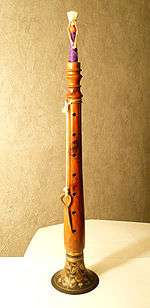Shehnai
 | |
| Other names | Shahnai, Shenai, Sahanai, Sanai, Shenoy, Shanai |
|---|---|
| Classification | |
| Related instruments | |
The shehnai is a musical instrument, originating from the Indian subcontinent. It is made out of wood, with a double reed at one end and a metal or wooden flared bell at the other end.[1][2][3] Its sound is thought to create and maintain a sense of auspiciousness and sanctity and, as a result, is widely used during marriages, processions and in temples although it is also played in concerts. The shehnai is similar to South India's nadaswaram.
Characteristics
This tubular instrument gradually broadens towards the lower end. It usually has between six and nine holes. It employs one set of quadruple reeds, making it a quadruple reed woodwind. By controlling the breath, various tunes can be played on it.
The shehnai has a range of two octaves, from the A below middle C to the A one line above the treble clef (A3 to A5 in scientific pitch notation).
Frequently, the instrument’s flared open end is made of metal while its body is made of wood or bamboo; however, they are not exclusively made in this fashion.[4]
Origin of the shehnai
The shehnai is thought to have been developed by improving upon the pungi (a woodwind folk instrument used primarily for snake charming).
Another theory of the origin of the shehnai is that the name is a modification of the word "sur-nal". The word nal/nali/nad is used in many Indian languages to mean pipe or reed. The word "sur" means tone or tune—musical note or simply music—and is used as a prefix to the names of many Indian instruments. The "sur-nal" is said to have given its name to the "surna/zurna" which is the name by which the reed-pipe is known throughout the Middle East and eastern Europe. Shehnai is usually played at traditional North Indian weddings and is associated with the bride leaving her parental house for her husband's house.[5] Sometimes, two shehnais can be tied together, making it a double shawm similar to the ancient Greek aulos.[6]
Whereas the counterparts played in West Indian and Coastal Karnataka are indigenous to the territory. Shenai players were/are an integral part of Goan/Konkani and temples along the western coast and the players are called as Vajantri and they were allotted lands for services rendered for the temples.[7]
Notable Indian shehnai players
See also
- Reed instrument, a type of woodwind instrument
- Shawm, a type of reed instrument
- Mizmar, a shawm similar to the shehnai
- Nadaswaram, a similar South Indian instrument
Notes
- ↑ Shehnai Britannica.com.
- ↑ Ranade. p. 307.
- ↑ Hoiberg, p. 1
- ↑ (N.A), (N.A.). "shehnai". https://www.metmuseum.org. Allen Roda. Retrieved March 2009. Check date values in:
|accessdate=(help); External link in|website=(help) - ↑ Dileep Karanth, The Indian Oboe Reexamined, E-ASPAC 2005, retrieved 5 May 2008
- ↑ Chalumeau double (picture from the book "Illustrated encyclopedia of Musical Instruments".there are also reeds that are blown through to make it vibrate to make the sound come out
- ↑ Gazetteer of the Union Territory Goa, Daman and Diu: district gazetteer, Volume 1. Gazetteer Dept., Govt. of the Union Territory of Goa, Daman and Diu,. 1979.
References
- Ranade, Ashok Damodar (2006). Music contexts: a concise dictionary of Hindustani Music. Bibliophile South Asia. ISBN 81-85002-63-0.
- Hoiberg, Dale; Indu Ramchandani (2000). Students' Britannica India. Popular Prakashan.
